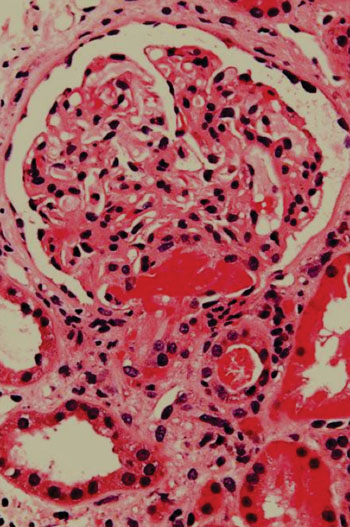Platelet Transfusions for Rare Blood Cell Disorders Increases Mortality Risk
By HospiMedica International staff writers
Posted on 29 Jan 2015
Patients hospitalized with certain rare blood cell disorders frequently receive a treatment that is associated with a two- to fivefold increase in death.Posted on 29 Jan 2015
The risks and benefits associated with platelet transfusions have been studied in the rare blood disorders thrombotic thrombocytopenic purpura (TTP), heparin induced thrombocytopenia (HIT) and immune thrombocytopenic purpura (ITP).

Image: Histology of a kidney biopsy from a patient with thrombotic thrombocytopenic purpura (TTP) showing an acute thrombotic microangiopathy (Photo courtesy of Nephron).
Medical experts in transfusion medicine at the Johns Hopkins University School of Medicine (Baltimore, MD, USA) carried out a nationwide review of nearly 100,000 combined hospital admissions for three rare blood cell disorders: TTP, HIT and ITP. All three conditions are immune system disorders marked by low levels of platelets that help seal up damaged blood vessels. TTP is a life-threatening condition in which clots form in small blood vessels, resulting in a low overall platelet count. It occurs in less than one out of every 100,000 people per year. ITP is a less serious tendency to bleeding, seen in about one in every 20,000 children and one in every 50,000 adults, which often clears up on its own. HIT is a life-threatening reaction to the drug heparin, given to patients to prevent the formation of blood clots. For unknown reasons, in about 1% to 5% of patients given heparin, the immune system responds by producing clots rather than suppressing them.
Platelet transfusions were reported in 10.1% of all hospitalizations for TTP, 7.1% for HIT and 25.8% for ITP. In TTP, the odds of dying in the hospital doubled when the patient was given a platelet transfusion. In HIT, the odds of dying were five times greater with a platelet transfusion.
The scientists found that one in 10 TTP patients and one in 13 HIT patients got platelet transfusions, in spite of some practitioners' concerns about the risks. In some cases, the doctors may not have known the patient has a platelet disorder until they see the potentially deadly reaction to the transfusion.
Aaron A. R. Tobian, MD, PhD, an associate professor of pathology, said, “Because these conditions are so rare, they're difficult to study. There was some suggestion that transfusion may be harmful in these conditions, but it really was not known until now. Our study is the first one to show that platelet transfusions are frequently administered to patients with ITP, HIT and TTP, and that they're associated with higher odds of arterial blood clots and mortality in TTP and HIT.” The authors believe that for patients with HIT and TTP, platelet transfusions should be reserved only for severe, life-threatening bleeding refractory to other therapies or major surgery. For HIT patients, the first step is to stop administering heparin, and TTP patients should be transferred to a hospital that can administer plasma exchange therapy. The study was published on January 14, 2015, in the journal Blood.
Related Links:
Johns Hopkins University School of Medicine














